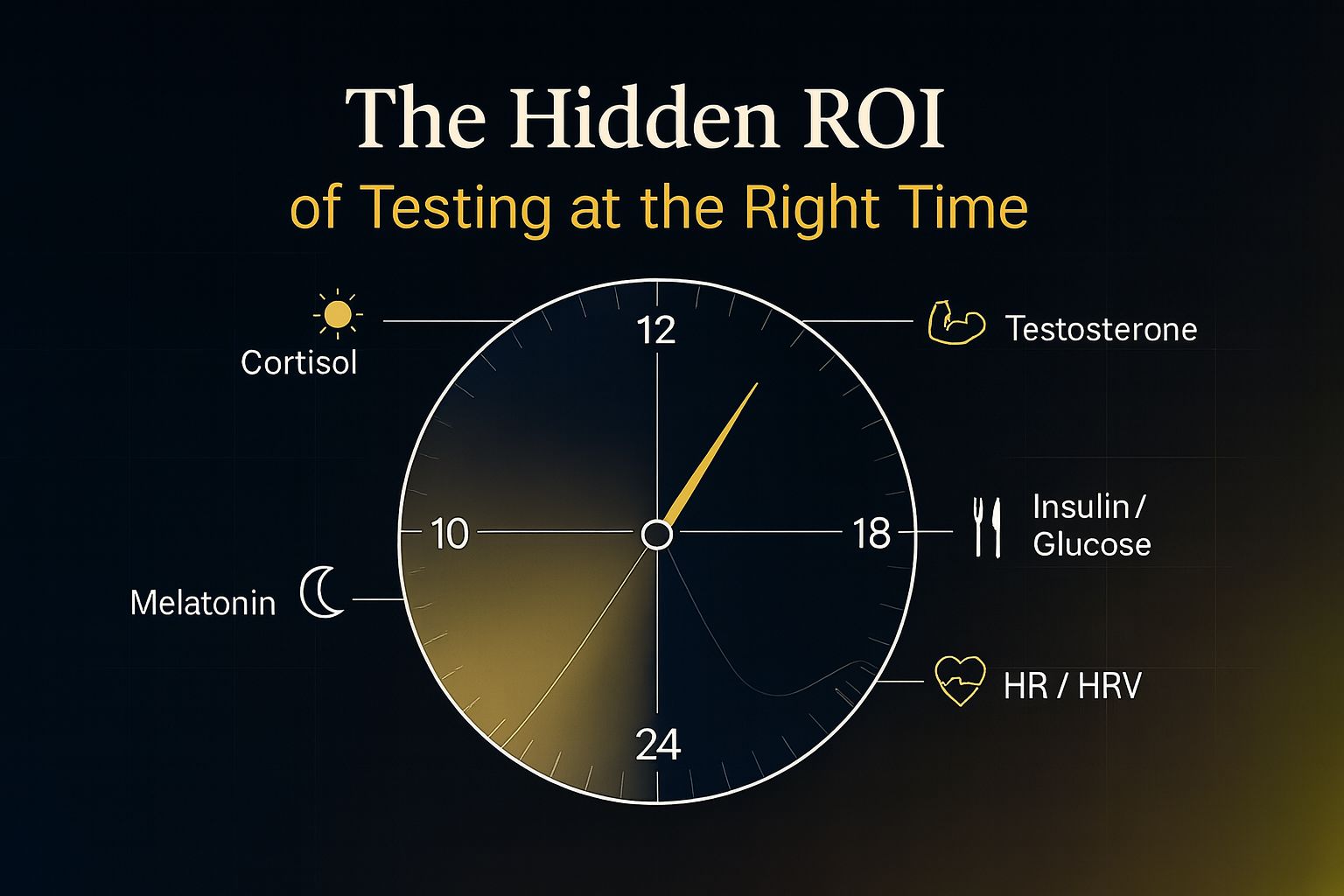- The Long Game
- Posts
- 🕓 The Hidden ROI of Testing at the Right Time
🕓 The Hidden ROI of Testing at the Right Time
Your biology moves in cycles. The smartest investors measure with it, not against it.

In investing, timing can make or break your returns.
The same is true in biology.
Test a biomarker at the wrong hour, and you’re reading noise, not signal.
The difference between a 7:30 AM draw and a 4:00 PM draw can look like two different people - even if nothing changed except the clock.
Most founders measure progress quarterly. Most athletes, daily.
But your biology operates hourly.
Cortisol, testosterone, insulin, and even heart rate all follow precise daily rhythms.
If you don’t measure them in context, you’ll interpret a timing difference as a performance problem.
I learned this the hard way.
Two years ago, I ran a full panel during a red-eye week - cortisol looked low, testosterone looked “normal.”
Three months later, same lab, same tests, but this time after a recovery phase: cortisol was 60% higher, testosterone up 25%.
It wasn’t the supplements.
It was the timing.
The Timing–Testing Matrix
The Matrix is simple but powerful. It aligns your testing windows with your biological peaks - so your data reflects true performance, not distortion.
Biomarker | Best Testing Window | What It Reflects | Why It Matters |
|---|---|---|---|
Cortisol | 7:00–9:00 AM, within 30 min of waking | Stress adaptation, energy curve | Peaks after sunrise — your “market open.” |
Testosterone | 7:00–9:00 AM, fasted | Recovery, drive, anabolic state | 30% higher in morning; declines by afternoon. |
Insulin / Glucose | 8:00–10:00 AM, fasted | Metabolic efficiency | Morning sensitivity = cleaner glucose handling. |
HR / HRV | Upon waking | Recovery readiness | Best signal-to-noise when rested and fasted. |
Melatonin | 10:00 PM–2:00 AM | Sleep rhythm & light exposure | Peaks in darkness; reveals circadian alignment. |
System Insight: Time-Normalized Data
A lab result isn’t a number - it’s a timestamp.
Without context, comparing a 4 PM cortisol to an 8 AM baseline is like comparing Q2 to Q4 revenue without adjusting for seasonality.
Precision timing gives you time-normalized data, which means your interventions become compoundable - measurable, repeatable, and strategic.
That’s what high-performance founders crave: signal, not stories.
Operator Integration
Here’s how I operationalize timing data in my own performance systems:
1️⃣ Standardize your draws. Always test at the same time of day, same posture, and same fasting state.
2️⃣ Control your environment. Avoid bright light or caffeine before hormonal labs.
3️⃣ Pair lab data with wearables. I use Oura or Whoop to track HRV trends between lab cycles.
4️⃣ Annotate the data. Record travel, stress, and sleep status in your notes — it helps decode fluctuations later.
5️⃣ Focus on deltas. Don’t chase one-off numbers; track directionality across 3–4 consistent cycles.
Founder Lens
When an investor says, “We need to compare apples to apples,” they’re describing data consistency.
Your biology is no different.
If you test inconsistently, your numbers are just anecdotes.
When you standardize timing, they become insights.
That shift - from random testing to rhythmic testing - is how you start building your Biological P&L.
The System Payoff
Founders who master timing aren’t chasing hacks; they’re building repeatability.
They make decisions when their cortisol is high enough for clarity, and their testosterone hasn’t yet dropped from fatigue.
They time their training, board calls, and even negotiations inside their natural peaks.
The result? Sharper calls, faster recovery, better long-term compounding.
The Long Game
Every great investor knows: you don’t just need the right data - you need the right timestamp.
Biology works the same way.
The more precisely you measure, the more confidently you can move.
♻️ Forward this to one operator or founder who still thinks “labs are just for sick people.”
~ Sandy